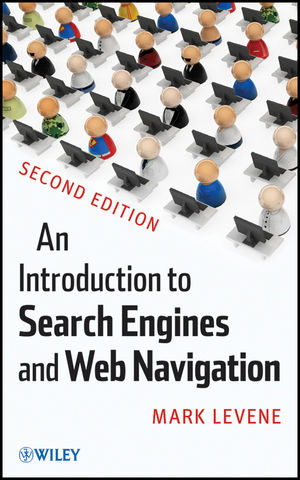
An Introduction to Search Engines and Web Navigation
John Wiley & Sons Inc (Verlag)
978-0-470-52684-2 (ISBN)
This book is a second edition, updated and expanded to explain the technologies that help us find information on the web. Search engines and web navigation tools have become ubiquitous in our day to day use of the web as an information source, a tool for commercial transactions and a social computing tool. Moreover, through the mobile web we have access to the web's services when we are on the move. This book demystifies the tools that we use when interacting with the web, and gives the reader a detailed overview of where we are and where we are going in terms of search engine and web navigation technologies.
Mark Levene, PhD, is Professor of Computer Science, head of the Computer Science and Information Systems Department, and a member of the Information Management and Web Technologies Group at Birkbeck, University of London. His main current research interests are Web search and navigation, Web mining, and Web interaction. Professor Levene is the coauthor of A Guided Tour of Relational Databases and Beyond and the coeditor of Web Dynamics.
PREFACE. LIST OF FIGURES.
CHAPTER 1 INTRODUCTION.
1.1 Brief Summary of Chapters.
1.2 Brief History of Hypertext and the Web.
1.3 Brief History of Search Engines.
CHAPTER 2 THE WEB AND THE PROBLEM OF SEARCH.
2.1 Some Statistics.
2.2 Tabular Data Versus Web Data.
2.3 Structure of the Web.
2.4 Information Seeking on the Web.
2.5 Informational, Navigational, and Transactional Queries.
2.6 Comparing Web Search to Traditional Information Retrieval.
2.7 Local Site Search Versus Global Web Search.
2.8 Difference Between Search and Navigation.
CHAPTER 3 THE PROBLEM OF WEB NAVIGATION.
3.1 Getting Lost in Hyperspace and the Navigation Problem.
3.2 How Can the Machine Assist in User Search and Navigation.
3.3 Trails Should be First Class Objects.
3.4 Enter Markov Chains and Two Interpretations of Its Probabilities.
3.5 Conflict Between Web Site Owner and Visitor.
3.6 Conflict Between Semantics of Web Site and the Business Model.
CHAPTER 4 SEARCHING THE WEB.
4.1 Mechanics of a Typical Search.
4.2 Search Engines as Information Gatekeepers of the Web.
4.3 Search Engine Wars, is the Dust Settling?
4.4 Statistics from Studies of Search Engine Query Logs.
4.5 Architecture of a Search Engine.
4.6 Crawling the Web.
4.7 What Does it Take to Deliver a Global Search Service?
CHAPTER 5 HOW DOES A SEARCH ENGINE WORK.
5.1 Content Relevance.
5.2 Link-Based Metrics.
5.3 Popularity-Based Metrics.
5.4 Evaluating Search Engines.
CHAPTER 6 DIFFERENT TYPES OF SEARCH ENGINES.
6.1 Directories and Categorization of Web Content.
6.2 Search Engine Advertising.
6.3 Metasearch.
6.4 Personalization.
6.5 Question Answering (Q&A) on the Web.
6.6 Image Search.
6.7 Special Purpose Search Engines.
CHAPTER 7 NAVIGATING THE WEB.
7.1 Frustration in Web Browsing and Navigation.
7.2 Navigation Tools.
7.3 Navigational Metrics.
7.4 Web Data Mining.
7.5 The Best Trail Algorithm.
7.6 Visualization that Aids Navigation.
7.7 Navigation in Virtual and Physical Spaces.
CHAPTER 8 THE MOBILE WEB.
8.1 The Paradigm of Mobile Computing.
8.2 Mobile Web Services.
8.3 Mobile Device Interfaces.
8.4 The Navigation Problem in Mobile Portals.
8.5 Mobile Search.
CHAPTER 9 SOCIAL NETWORKS.
9.1 What is a Social Network?
9.2 Social Network Analysis.
9.3 Peer-to-Peer Networks.
9.4 Collaborative Filtering.
9.5 Weblogs (Blogs).
9.6 Power-Law Distributions in the Web.
9.7 Searching in Social Networks.
9.8 Social Tagging and Bookmarking.
9.9 Opinion Mining.
9.10 Web 2.0 and Collective Intelligence.
CHAPTER 10 THE FUTURE OF WEB SEARCH AND NAVIGATION.
BIBLIOGRAPHY.
INDEX.
| Erscheint lt. Verlag | 5.3.2018 |
|---|---|
| Verlagsort | New York |
| Sprache | englisch |
| Maße | 158 x 236 mm |
| Gewicht | 762 g |
| Themenwelt | Mathematik / Informatik ► Informatik ► Netzwerke |
| Mathematik / Informatik ► Informatik ► Web / Internet | |
| ISBN-10 | 0-470-52684-X / 047052684X |
| ISBN-13 | 978-0-470-52684-2 / 9780470526842 |
| Zustand | Neuware |
| Informationen gemäß Produktsicherheitsverordnung (GPSR) | |
| Haben Sie eine Frage zum Produkt? |
aus dem Bereich


